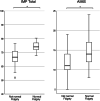Concurrent and predictive validity of the infant motor profile in infants at risk of neurodevelopmental disorders
- PMID: 33549070
- PMCID: PMC7866878
- DOI: 10.1186/s12887-021-02522-5
Concurrent and predictive validity of the infant motor profile in infants at risk of neurodevelopmental disorders
Abstract
Background: Preterm infants and infants with perinatal brain injury show a higher incidence of neurodevelopmental disorders (NDD). The Infant Motor Profile (IMP) is a clinical assessment which evaluates the complexity of early motor behaviour. More data are needed to confirm its predictive ability and concurrent validity with other common and valid assessments such as the Alberta Infant Motor Scale (AIMS) and Prechtl's General Movement Assessment (GMA). The present study aims to evaluate the concurrent validity of the IMP with the AIMS, to assess its association with the GMA, to evaluate how the IMP reflects the severity of the brain injury and to compare the ability of the IMP and the AIMS to predict an abnormal outcome in 5-month-old infants at risk of NDD.
Methods: 86 infants at risk of NDD were retrospectively recruited among the participants of two clinical trials. Preterm infants with or without perinatal brain injury and term infants with brain injury were assessed at 3 months corrected age (CA) using the GMA and at 5 months CA using the IMP and the AIMS. The neurodevelopmental outcome was established at 18 months.
Results: Results confirm a solid concurrent validity between the IMP Total Score and the AIMS (Spearman's ρ 0.76; p < .001) and a significant association between IMP Total Score and the GMA. Unlike the AIMS, the IMP Total score accurately reflects the severity of neonatal brain injury (p < .001) and proves to be the strongest predictor of NDD (p < .001). The comparison of areas under receiver operating characteristic curves (AUC) confirms that the IMP Total score has the highest diagnostic accuracy at 5 months (AUC 0.92). For an optimal IMP Total Score cut-off value of 70, the assessment shows high sensitivity (93%) and specificity (81%) (PPV 84%; NPV 90%).
Conclusions: Early motor behaviour assessed with the IMP is strongly associated with middle-term neurodevelopmental outcome. The present study confirms the concurrent validity of the IMP with the AIMS, its association with the GMA and its ability to reflect brain lesion load, hence contributing to the construct validity of the assessment.
Trial registration: NCT01990183 and NCT03234959 (clinicaltrials.gov).
Keywords: Alberta infant motor scale; Infant motor profile; Neurodevelopmental disorder, general movement assessment.
Conflict of interest statement
The authors report no competing interests.
Figures




References
-
- Spittle A, Orton J, Anderson P, Boyd R, Doyle LW. Early developmental intervention programmes post-hospital discharge to prevent motor and cognitive impairments in preterm infants. Cochrane Database Syst Rev. 2012;12:1–100. - PubMed
-
- Caesar R, Colditz PB, Cioni G, Boyd RN. Clinical tools used in young infants born very preterm to predict motor and cognitive delay (not cerebral palsy): a systematic review. Dev Med Child Neurol. 2020:1–9. - PubMed
Publication types
MeSH terms
Associated data
Grants and funding
LinkOut - more resources
Full Text Sources
Other Literature Sources
Medical

